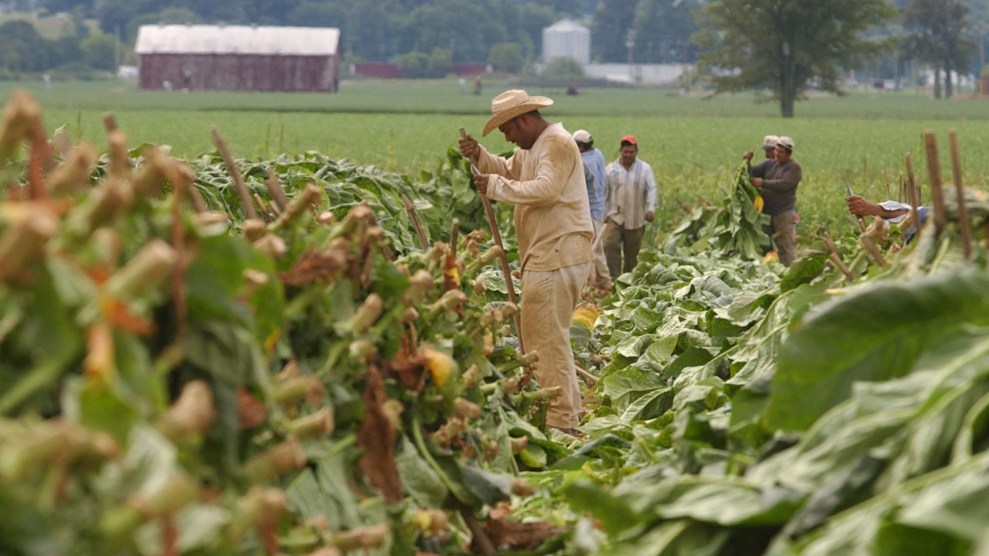Did Trump Just Cut Guest Farmworker Wages by as Much as 50 Percent?
OCTOBER 2, 2020
A surprise move by the agriculture department may have done just that.

H-2A farm workers in Owensboro, Ky. Jenny Sevcik/Messenger-Inquirer/AP
For all of its virulent xenophobia, the Trump administration does seem to cherish one form of immigration: the federal visa program for guest farmworkers, known as H-2A. Under Trump, the number of foreign nationals receiving H-2A visas has surged from 134,368 in 2016 to 204,801 in 2019. One reason for this H-2A exceptionalism may be that the program has long been notoriously geared to serve the interests of farmers over the workers themselves. While in the program, at the mercy of their employers, some workers have been subjected to abuses like wage theft and substandard housing.
And now, even as farms grow ever more-reliant on the program for labor, and even as the coronavirus pandemic makes farm work even more dangerous than it already was, Trump may have found a way to make it more farmer-friendly and anti-worker still: by slashing wages. The US Department of Agriculture recently executed a bureaucratic maneuver that could do just that, says Evy Peña, communications and development director for the Mexico-based Centro de los Derechos del Migrante (Center for Immigrant Rights).
Understanding how requires some background. Guest-worker wages vary by state, through a mechanism that prevents farmers from paying them less than the prevailing rate in the surrounding area, which would undermine bargaining power for other nearby workers. This “adverse effect wage rate,” calculated for each state by the US Department of Labor, ranges from $11.71 per hour in Florida, Alabama, and Georgia, to around $15 on the west coast. To calculate the rate, the labor department relies on the Agricultural Labor Survey, a twice-a-year polling of farmers conducted by the USDA.
In a surprise move, the USDA announced on Sept. 30 that it would not conduct the survey in October because the “USDA has determined the public can access other data sources for the data.” But without the survey, Peña says, the “Department of Labor won’t have the data to set the adverse effect wage rate,” and as a result, H-2A workers pay will revert to each state’s minimum wages—in most cases, lower than the adverse effect rate. Bruce Goldstein, president of Farmworker Justice, echoes that analysis. “The adverse effect wage rate, by DOL regulation, is based on this survey; no survey, no adverse effect wage rate,” he said. This of course hurts H-2A workers’ income, and it means that local farmworkers not in the H-2A program may have a harder time competing for jobs or bargaining for raises.
The Department of Labor has not responded to a query about whether the USDA’s move will do away with the higher rates. Its secretary, Eugene Scalia (son of the late Supreme Court justice Antonin Scalia), is a former “management side” labor lawyer with a history of pushing the interests of big business over those of low-wage workers.
And slashing wages for H-2A workers has been an explicit goal of USDA secretary Sonny Perdue’s, a former governor of Georgia with extensive agribusiness ties, for nearly a year. Back in January, he told attendees at an agribusiness conference that “we have to do something” to cut the program’s above-minimum wages. In April, NPR’s Franco Ordoñez reported that Perdue was working with White House allies to “see how to reduce wage rates for foreign guest workers on American farms,” using reduced farm sales because of the pandemic as an excuse.
For workers in many states, the pay cut would be substantial. In Perdue’s home state of Georgia, with its labor-intensive $14 billion agriculture industry, the current hourly rate for H-2A workers stands at $11.71, while the minimum wages stands at $7.25. A move from the adverse effect wage rate to the minimum rate would amount to a 38 pay percent cut. In neighboring Florida, which also boasts a large, labor-intensive farm economy, the pay cut for H2-A workers would amount to 26 percent.
Then there’s Iowa, home state of USDA under secretary for farm production and conservation Bill Northey, who signed the decree canceling the Agricultural Labor Survey. In that state, the adverse effect wage rate for H-2A workers stands at $14.58 while the minimum wage stands at $7.25. That’s would be a more than 50 percent pay cut. Before joining the Trump administration, Northey served as the secretary of Iowa’s agriculture department.
The cuts, if they’re realized, come at a time when the workers who feed the United States operate under severe stress from the threat of COVID-19.” The wages of workers who are putting their lives at risk while feeding the country are far too low already,” Peña said. “This pay cut would only increase the risk of exploitation for an already vulnerable population.”








Follow Us!